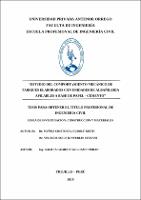Mostrar el registro sencillo del ítem
Estudio del comportamiento mecánico de tabiques elaborados con unidades de albañilería apilables a base de papel - cemento
| dc.contributor.advisor | Galicia Guarniz, William Conrad | |
| dc.contributor.author | Muñoz Cristobal, Rudolf Keith | |
| dc.contributor.author | Velarde Solis, Kinverlin Stefani | |
| dc.creator | Muñoz Cristobal, Rudolf Keith | |
| dc.date.accessioned | 2019-06-03T21:40:29Z | |
| dc.date.available | 2019-06-03T21:40:29Z | |
| dc.date.issued | 2019 | |
| dc.identifier.uri | https://hdl.handle.net/20.500.12759/4894 | |
| dc.description.abstract | En la industria de la construcción existen diversas formas de construcción de muros, siendo todos ellos altamente contaminantes y sin una política eco sostenible, que nos ayude a mejorar el medio ambiente, tal es así, que la construcción de albañilería es uno de los sistemas más utilizado para la ejecución de viviendas en zonas urbanas, por su costo y facilidad. Aquí es donde encajan los tabiques, que son elementos no estructurales elaborados a base de ladrillos pandereta, para aligerar los pesos de la edificación. Es por eso que, al ser el material que más genera residuos en la industria de la construcción (23.33%), se optó por estudiar una nueva composición de materiales teniendo como componente agregado al papel, para tal fin se construyeron unidades de albañilería apilable KR tipo I (macho), tipo II (nexo), tipo III (hembra), con una composición de mezcla de 1 (papel), 0.1 (cemento), 2.5(Agua). Los resultados obtenidos muestran que el comportamiento mecánico, en su forma de carga, obtuvo una resistencia de 10.33 Kg/cm2 para unidades de albañilería apilable KR tipo I, 9.21 Kg/cm2 para unidades de albañilería apilable KR tipo III y 7.91 Kg/cm2 para unidades de albañilería apilable KR tipo III. Adicionalmente se estudió la compresión diagonal a muretes de albañilería, teniendo como resultado 0.63 Kg/cm2. Concluyendo que, las unidades de albañilería apilables pueden ser utilizadas para muros simples, los cuales no cumplen funciones estructurales. | es_PE |
| dc.description.abstract | In the construction industry there are various forms of construction of walls, all of which are highly polluting and without a sustainable eco policy, which helps us improve the environment, such that the construction of masonry is one of the most used for the execution of housing in urban areas, for its cost and ease. This is where the partitions fit, which are non-structural elements based on tambourine bricks, to lighten the building weights. That is why, being the material that generates the most waste in the construction industry (23.33%), it was decided to study a new composition of materials having as an added component to paper, for this purpose were built stackable masonry units KR type I (male), type II (nexus), type III (female), with a mixture composition of 1 (paper), 0.1 (cement), 2.5 (Water). The results obtained show that the mechanical behavior, in its load form, obtained a resistance of 10.33 Kg / cm2 for stackable masonry units KR type I, 9.21 Kg / cm2 for stackable masonry units KR type III and 7.91 Kg / cm2 for Stackable masonry units KR type III. Additionally, the diagonal compression of masonry walls was studied, resulting in 0.63 Kg / cm2. Concluding that, stackable masonry units can be used for simple walls, which do not fulfill structural functions. | en_US |
| dc.description.uri | Tesis | es_PE |
| dc.format | application/pdf | es_PE |
| dc.language.iso | spa | es_PE |
| dc.publisher | Universidad Privada Antenor Orrego | es_PE |
| dc.relation.ispartofseries | T_ING.CIVIL_1731 | |
| dc.rights | info:eu-repo/semantics/closedAccess | es_PE |
| dc.rights.uri | https://creativecommons.org/licenses/by/4.0/ | es_PE |
| dc.source | Universidad Privada Antenor Orrego | es_PE |
| dc.source | Repositorio Institucional - UPAO | es_PE |
| dc.subject | Unidades de albañilería | es_PE |
| dc.subject | Compresión | es_PE |
| dc.subject | Papel ecológico | es_PE |
| dc.title | Estudio del comportamiento mecánico de tabiques elaborados con unidades de albañilería apilables a base de papel - cemento | es_PE |
| dc.type | info:eu-repo/semantics/bachelorThesis | es_PE |
| thesis.degree.level | Título Profesional | es_PE |
| thesis.degree.grantor | Universidad Privada Antenor Orrego. Facultad de Ingeniería | es_PE |
| thesis.degree.name | Ingeniero Civil | es_PE |
| thesis.degree.discipline | Ingeniería Civil | es_PE |
| dc.publisher.country | PE | es_PE |
Ficheros en el ítem
Este ítem aparece en la(s) siguiente(s) colección(es)
-
Ingeniería Civil [1149]


